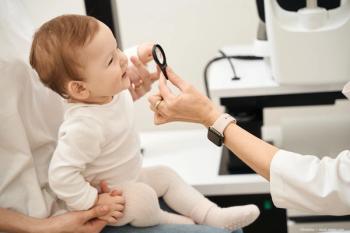
Intranasal neurostimulator shows benefit for increasing tear production
Results from two pivotal multicenter trials demonstrate that an intranasal tear neurostimulator (TrueTear, Allergan) safely and effectively increases endogenous tear production in patients with dry eye disease (DED), said Edward Holland, MD.
Results from two pivotal multicenter trials demonstrate that an intranasal tear neurostimulator (TrueTear, Allergan) safely and effectively increases endogenous tear production in patients with dry eye disease (DED), said Edward Holland, MD.
“These data support the use of the intranasal tear neurostimulator as a promising treatment option for patients with DED,” said Dr. Holland, director, Cornea Services, Cincinnati Eye Institute, and professor of ophthalmology, University of Cincinnati, Cincinnati, OH.
The handheld device has a rechargeable base unit and a disposable tip with two prongs that are inserted into the nostrils. Small electrical pulses are transmitted to the ends of the tip, stimulating the trigeminal afferent nerve in the nasal mucosa and triggering the nasolacrimal reflex pathway.
The two pivotal studies included a one-day crossover trial that compared active intranasal tear neurostimulator treatment against two controls:
- application of a non-electrical sham device with a short, limited insertion tip, and
- by patients in a randomized sequence at a single visit.
To be eligible for participation, patients had to have a Schirmer score (with anesthesia) ≤10 mm/5min, a cotton swab stimulated score ≥7 mm higher in the same eye, an Ocular Surface Disease Index (OSDI) score ≥13, and no history of significant nasal or sinus disease.
The study enrolled 48 patients with a mean age of 57 years. They were predominantly female. Baseline unstimulated Schirmer score averaged 5.5 and the mean baseline OSDI score was 41.5.
Effectiveness was analyzed using the Schirmer test to measure stimulated tear production. The results showed that tear production was significantly greater (p < 0.001) during the active intranasal application (~25 mm) compared with both controls (<10 mm).
The second study included 97 patients. It was a 180-day, open-label trial that compared changes in Schirmer score before and during intranasal stimulation when measured at baseline and after 7, 30, 90, and 180 (primary outcome) days.
Eligibility for this study used the same Schirmer score and cotton swab stimulated score criteria, but required an OSDI ≥23, corneal fluorescein staining (CFS) score ≥2 in at least one of five corneal regions, and a sum (CFS) score ≥4 for all corneal regions in the same eye.
At baseline, mean CFS score was 7.5 in study eyes and the mean OSDI score was 52.
Data on device usage showed that patients applied the treatment an average of 1.7 times per day for an average application time of 2.2 minutes/day. The mean number of treatment applications per subject over the 6-month study period was 288, Dr. Holland reported.
“Patients were instructed to use the [device] a minimum of 2 times daily and up to 10 times a day as needed and for no more than 3 minutes per use,” he said.
The primary endpoint analysis showed the treatment significantly increased acute tear production at 180 days (p < 0.0001). Secondary efficacy analyses showed there was a statistically significant treatment effect at all other visits.
“The data from this study corroborate the significant increase in acute tear production found in the single day study and demonstrate the durability of the response,” Dr. Holland said.
Favorable safety
The majority of adverse events reported in the trials were mild or moderate in severity. The most common device-related adverse events reported in the second trial were nasal pain, discomfort or burning (10%) followed by nosebleed and transient electrical discomfort (5% each).
“No serious device-related adverse events were reported in either study,” Dr. Holland said.
Expert insights
Dr. Holland said that in addition to stimulating aqueous tear production, there is evidence that the treatment stimulates mucin and meibomian gland secretions. He posited that the resulting improvement in tear film quality enables ocular surface healing over time, leading to symptom relief and resulting in decreased use of the device.
“We were concerned that over time, the number of applications per day would increase,” he observed. “What we found in one trial was that usage actually decreased over time, and I think that is because the treatment is affecting the three major components of the tear film.”
Dr. Holland also noted that the treatment was well-received by patients.
“I did not think patients would want to use it, but we had no problems recruiting for the studies,” he said.
He noted that patients need to be given good education so that they will use the device properly.
“People tend to insert the tips barely into the nose and posteriorly. To be effective and hit the nerve target, the tips have to be positioned fairly superior and anterior,” Dr. Holland explained.
Dr. Holland is a consultant for Allergan and to other companies marketing and developing treatments for DED.
Newsletter
Don’t miss out—get Ophthalmology Times updates on the latest clinical advancements and expert interviews, straight to your inbox.



















































.png)


